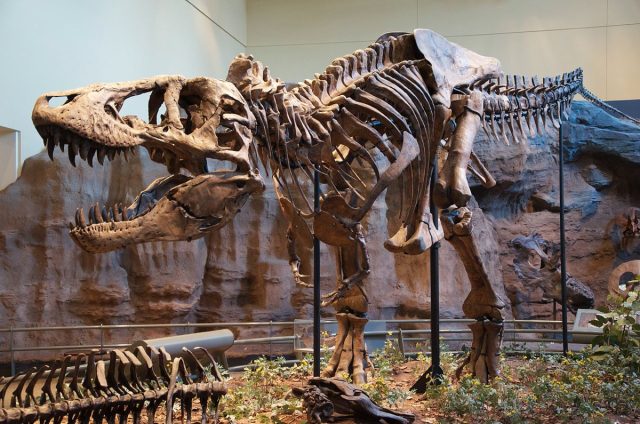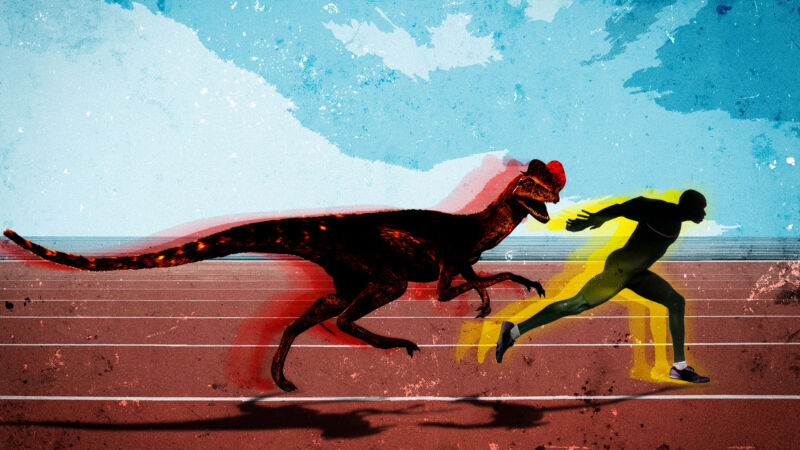The early Jurassic dinosaurs known as Dilophosaurus proved to be scene stealers in the 1993 blockbuster Jurassic Park, taking out a full-grown man who thought they were just cute, harmless critters—right until they disabled him by spitting venom into his eyes. But how would Dilophosaurus fare in a different kind of contest: racing the 100-meter dash against eight-time Olympic gold medalist Usain Bolt? It wouldn't be much of a fight—Bolt would easily beat the 900-pound beast by a good two seconds.
That's the conclusion of physicist Scott Lee of the University of Toledo, based on a physics exercise he developed for his undergraduate students in introductory physics. Lee has loved dinosaurs ever since he was a kid, when he would hunt for fossils with his family, and he has brought that love into the classroom. "One big issue in physics education is to generate student enthusiasm for the course material," he said. "These dinosaur problems really spark a lot of interest among the students." He described his pedagogical process in a new paper published in The Physics Teacher.
Bolt made his mark on history in the 2008 Summer Olympics in Beijing, when he broke his own world record in the 100-meter final, blazing past the competition to win the gold with a time of 9.69 seconds. He was so far ahead of the pack—the silver medalist finished in 9.89 seconds—that Bolt visibly slowed down in celebration right at the finish. Had he kept running at full speed, Bolt would have finished in 9.52 seconds, his coach estimated. This conclusion was borne out by an analysis by physicists at the University of Oslo, whose calculations predicted a finish in about 9.55 seconds.

At the 2009 World Championships in Berlin, Bolt broke his own 100-meter record again with a time of 9.58 seconds—the biggest improvement since the implementation of electronic timing. According to a 2013 study by physicists at the National Autonomous University of Mexico, Bolt's acceleration out of the starting block was 9.5 meters per second squared, and the sprinter was producing 2.6 kilowatts of power (3.5 horsepower) less than a second later.
The 6-foot 5-inch Bolt is taller than the average sprinter, which means he takes fewer steps than his opponents when he runs. However, he also experiences more air resistance. The authors found that less than 8 percent of Bolt's energy was used for running, while 92 percent was used to overcome aerodynamic drag. They also suggested that Bolt benefited from a mild tailwind during the 2009 race. Without it, his time would have been 9.68 seconds—still lower than his time at the 2008 Olympics but not quite as groundbreaking. With an even stronger tailwind, Bolt could have completed the race in a blistering 9.46 seconds.
Scientists have been equally fascinated by the question of maximum running speeds for various dinosaurs, particularly Tyrannosaurus rex. For instance, in 2002, researchers built a mathematical model to gauge the leg muscle mass needed to run faster than 25 mph (40 km/h). Most of these studies have varied widely in their methodologies, producing a broad range of possible maximum running speeds for T. Rex, from a poky 10-15 mph (16-24 km/hour) to about 45 mph (72 km/h). That averages out to around 20 mph (32 km/h).

One 2017 study pegged the top running speed for T. Rex at 17 mph (27 km/h), concluding that the animal would have exhausted its energy reserves well before reaching top speed. Another study that same year concluded that T. Rex probably wouldn't be able to run much at all, since any speed above 11 mph (18 km/h) would have shattered its leg bones. This analysis would also rule out running ability for other giant theropods like Giganotosaurus and Mapusaurus. (There are no fossilized tracks that show evidence of large theropods running, either.)
But T. Rex might nonetheless have been surprisingly agile for its size, according to a 2019 study. Thanks to low rotational inertia and large leg muscles, the T. Rex may have been capable of turning quickly—perhaps even performing a kind of "pirouette" on a single planted foot.
T. Rex was also a very efficient walker, according to a 2020 analysis of leg proportions, body mass, and gaits for 70 theropod species. A 2021 study estimated the animal's walking speed to be 2.9 mph (4.6 km). The authors also suggested that T. Rex's energy expenditure would have been reduced by the slight swing of its tail with each step, since the tail ligaments would store energy as they were stretched.



3175x175(CURRENT).thumb.jpg.b05acc060982b36f5891ba728e6d953c.jpg)

Recommended Comments
There are no comments to display.
Join the conversation
You can post now and register later. If you have an account, sign in now to post with your account.
Note: Your post will require moderator approval before it will be visible.